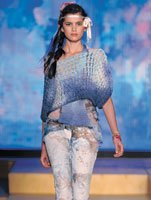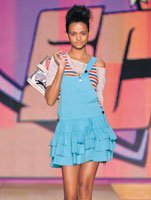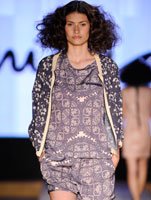Brazil's Apparel Industry Is Open for Business, but Challenges Abound
BELO HORIZONTE, Brazil—Business is bustling in Belo Horizonte, Brazil’s third-largest metropolitan area and home to Minas Trend Preview, a fashion trade fair and series of runway shows in their eighth year.
By day, retail buyers shop the more than 250 apparel, footwear and accessories brands showing on the trade-show floor at the Expo Minas convention center. At night, buyers join journalists and crowds of fashion fans in Expo Minas’ theater for well-organized, flashy catwalk shows featuring everything from denim and beachwear to party dresses and accessories.
With a thriving economy, a population of 203 million people and a strong currency, Brazil offers plenty of opportunity for international businesses, particularly for U.S. apparel and textile producers. But the barriers are high.
Brazilian consumers are fashion savvy and knowledgeable about American brands. The South American nation is the third-fastest-growing export market for the United States, according to the U.S. Department of Commerce’s Office of Textile and Apparel. But it is still a largely untapped market, as seen by the small amount of apparel sent to Brazil.
U.S. apparel exports to Brazil were up 64 percent to $18 million for the 12 months ending March 31, and textile exports were up 51 percent to $129 million during the same period, according to OTEXA statistics.
But the threat of international competition worries Brazilian leaders and businesspeople who want to protect their local market. International imports undermine Brazil’s domestic market, said Olavo Machado Jr., president of the Federation of Industries of Minas Gerais (FIEMG), the trade association that organizes Minas Trend Preview. He believes cheap imports could hamper Brazilian industries and contribute to unemployment.
“This is the problem,” said Machado, speaking through an interpreter. “With the exchange rate, it’s easier to sell here, but it’s not stable, not permanent.”Brazil’s high cost of businessManufacturers who set their sights on Brazil’s booming fashion market may find the costs daunting.
“It’s one of the most difficult countries to export to. There are more duties, fees and regulations than in most other countries, said Tom Gould, president of Tom Gould Customs Consulting and a senior compliance specialist at Zisser, a San Diego–based law firm that specializes in customs law.
Marc Willingham has first-hand experience with the challenges of cross-country business as president of U.S. operations for the Brazilian footwear collection Carmen Steffens.
“There’s a huge opportunity going into Brazil,” he said. “The currency is so strong, and the people are buying and they love big [international] brands [such as] Victoria’s Secret and MAC. The big challenge is the taxes and duties. It’s a protected market.”
Willingham said duties can add 40 percent to 60 percent to the cost of a garment, making imported fashion brands extremely pricy in Brazil. Plus, when Brazilian consumers are willing to pay very high prices for international brands, Brazilian labels with similar products adjust their prices accordingly, Willingham said.
Willingham recommended that U.S. companies interested in selling to Brazil study the market and adjust the offerings to the needs, tastes and quality requirements of the Brazilian consumer. Some of those requirements are more obvious than others. Because of their country’s warm climate, Brazilians prefer lighter-weight fabrics, he said. But, he added, they also tend to air-dry their laundry, so they do not need such stringent shrinkage requirements as American consumers, who tend to machine-dry clothing at high temperatures.
Willingham employs a similar strategy in his own business by cherry picking key footwear and handbag styles from Carmen Steffens’ extensive collection. Only the styles best suited for his American customers are slated for sale in the United States.
“Brazil is very similar to the United States,” he said. “What someone is going to buy in Nebraska is very different from what someone is going to buy in Miami versus Kansas or Los Angeles. We have that same type of diversity in Brazil. Being able to address those different market needs in Brazil—which is bigger than the continental United States—has allowed us to take a really broad product range and bring that to different countries. We might have 2,500 products in the collection in Brazil. We can choose 250 that are perfect for our market. That’s really important for people to understand. Start in the market you’re going to be in, define the need, define the products that are going to work and then make that happen.”
International companies should also be mindful of Brazil’s seasons, Willingham said, relaying an anecdote about a well-known luxury footwear line that stocked its Satilde;o Paolo boutique with boots during Brazil’s balmy summer months of November, December and January.
FIEMG’s Machado said rather than simply selling U.S. goods to Brazilian retailers, American companies should look for local partners in Brazil. FIEMG and other Brazilian trade associations provide matchmaking services to help international companies find business contacts in Brazil.
“An American company—especially one with money and technology—is welcome to come make a joint venture with our businesses,” Machado said. “It’s a smart solution for niche companies. We see American people as natural partners.”Fashion on the trade floorFor the brands showing at Minas Trend, the focus was making contacts with some of the 5,700 buyers shopping the trade show.
Located in Brazil’s state of Minas Gerais, Minas Trend Preview is Brazil’s forecast show, with companies showing their Spring/Summer 2012 collections. In addition to FIEMG, the trade show has the support of several other business associations: the Brazilian Textile and Apparel Industry Association (ABIT), the Brazilian Fashion Export Industry Program (Texbrasil) and the Brazilian Trade and Investment Promotion Agency (Apex-Brasil).
A steady stream of buyers walked the show, surveying a broad mix of products ranging from career knits and juniors denim to elaborate eveningwear, accessories and shoes. Many of the collections are based in Minas Gerais, and many company representatives said they source most of their fabrics from Brazil. (The country offers every stop on the apparel supply chain—from fiber and fabric to design, production and retail.)
Belo Horizonte–based Patachou sources all but a few of its textiles from Brazil, said Antonio Fonseca, marketing representative for the collection.
“Eighty percent of the silk is ours,” he said.
Patachou’s year-old little-sister line, Chouchou, is made exclusively with Brazilian textiles, including lightweight cotton knits and wovens, many featuring whimsical prints and cheeky graphics. (Chouchou was one of the collections shown on the runway at Minas Trend. Patachou shows in Rio.)
“We’ve tried to export,” Fonseca said, adding that seasonal differences make exporting to the Northern Hemisphere complicated. “The timing of retail is totally different, but the trends are the same because the market is global. Here, our clothes are competing with high-end brands like Dolce & Gabbana.”
Brazilian exports There are Brazilian brands making inroads into international markets, including the United States.
According to OTEXA, apparel imports from Brazil inched up 6.2 percent to $14.8 million for the 12 months ending March 31. Textile imports, however, were down 3.7 percent to $50 million.
For example, denim-based streetwear line Patoge sells its men’s and women’s apparel in Colombia and in three stores in the United States—two in New Jersey and one in Massachusetts. Nonetheless, the company is primarily focused on the Brazilian market, said company partner Patricia Castro.
“We’ve been invited to participate outside of Brazil, but inside is better,” Castro said through an interpreter.
(Patoge was also one of the lines shown on the runway at Minas Trend—where the appearance of Brazilian actor and model Rodrigo Hilbert on the catwalk prompted squeals of joy from the crowd.)
The brightly colored knits offered by Faven are exported to retailers in Canada, Portugal and the Middle East, according to company representative Sonia Pessoa, who said the company has twice participated in the Paris trade show Who’s Next.
Another knit line, Coven, also shows in Paris, at the Tranoi trade show, and sells its collection in the United States in Anthropologie stores and at Bergdorf Goodman, said marketing representative Arizio Melo.
Luciano Ribeiro, a representative of Trama Jeans, said he would like to sell his juniors line in the United States—in Los Angeles, in particular—but said it would be hard to compete with the prices offered at retailers such as Forever 21 and Hollister.
Despite the strength of the domestic market, Brazilian brands continue to court U.S. retailers. For the past two seasons, ABIT has organized a Brazil pavilion featuring several up-and-coming Brazilian apparel and footwear brands at the Project trade show in Las Vegas. Carmen Steffens was one of the participating labels.
The California Fashion Association also hosted a panel discussion at the show, educating Brazilian brands about selling to U.S. retailers. The Brazil pavilion is slated to return to Project for a third season in August.
























